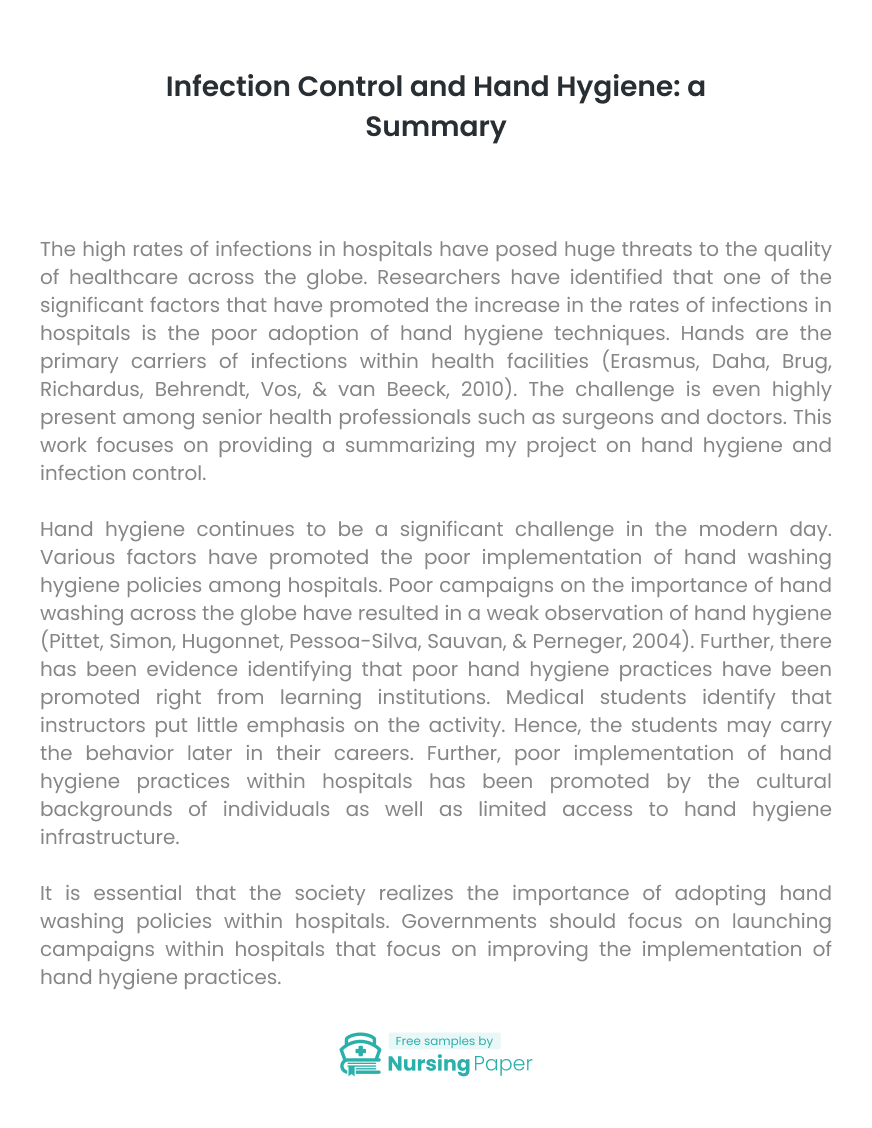
Infection Control and Hand Hygiene: a Summary
Introduction
The high rates of infections in hospitals have posed huge threats to the quality of healthcare across the globe. Researchers have identified that one of the significant factors that have promoted the increase in the rates of infections in hospitals is the poor adoption of hand hygiene techniques. Hands are the primary carriers of infections within health facilities (Erasmus, Daha, Brug, Richardus, Behrendt, Vos, & van Beeck, 2010). The challenge is even highly present among senior health professionals such as surgeons and doctors. This work focuses on providing a summarizing my project on hand hygiene and infection control.
Hand hygiene continues to be a significant challenge in the modern day. Various factors have promoted the poor implementation of hand washing hygiene policies among hospitals. Poor campaigns on the importance of hand washing across the globe have resulted in a weak observation of hand hygiene (Pittet, Simon, Hugonnet, Pessoa-Silva, Sauvan, & Perneger, 2004). Further, there has been evidence identifying that poor hand hygiene practices have been promoted right from learning institutions. Medical students identify that instructors put little emphasis on the activity. Hence, the students may carry the behavior later in their careers. Further, poor implementation of hand hygiene practices within hospitals has been promoted by the cultural backgrounds of individuals as well as limited access to hand hygiene infrastructure.


It is essential that the society realizes the importance of adopting hand washing policies within hospitals. Governments should focus on launching campaigns within hospitals that focus on improving the implementation of hand hygiene practices. Also, hospitals should be provided with access to hand washing equipment. Proper financial systems can ensure that quality hand washing material is supplied within medical institutions. Finally, learning institutions should emphasize the need for adopting hand hygiene behaviors among the health sciences students. The strategies will ensure that the rates of hand hygiene are increased among medical practitioners.
In conclusion, high rates of hand hygiene among medical practitioners promote reduced infection rates. The strategy can be used to improve the quality of the health sector effectively
1. Allegranzi, B., & Pittet, D. (2009). Role of hand hygiene in healthcare-associated infection prevention. Journal of Hospital Infection, 73(4), 305-315.
2. Erasmus, V., Daha, T. J., Brug, H., Richardus, J. H., Behrendt, M. D., Vos, M. C., & van Beeck, E. F. (2010). Systematic review of studies on compliance with hand hygiene guidelines in hospital care. Infection Control & Hospital Epidemiology, 31(3), 283-294.
3. Simon, A., Hugonnet, S., Pessoa-Silva, C. L., Sauvan, V., & Perneger, T. V. (2004). Hand hygiene among physicians: performance, beliefs, and perceptions. Annals of internal medicine, 141(1), 1-8.



The download will start shortly.

The download will start shortly.
 Subject:
Nursing
Subject:
Nursing  Number of pages: 5
Number of pages: 5  Subject:
Health and Social Care
Subject:
Health and Social Care  Number of pages: 6
Number of pages: 6  Subject:
Medicine
Subject:
Medicine  Number of pages: 2
Number of pages: 2  Subject:
Health and Social Care
Subject:
Health and Social Care  Number of pages: 4
Number of pages: 4  Subject:
Health and Social Care
Subject:
Health and Social Care  Number of pages: 2
Number of pages: 2  Subject:
Health and Social Care
Subject:
Health and Social Care  Number of pages: 6
Number of pages: 6  Subject:
Medicine
Subject:
Medicine  Number of pages: 2
Number of pages: 2  Subject:
Medicine
Subject:
Medicine  Number of pages: 2
Number of pages: 2  Subject:
Health and Social Care
Subject:
Health and Social Care  Number of pages: 5
Number of pages: 5  Subject:
Health and Social Care
Subject:
Health and Social Care  Number of pages: 5
Number of pages: 5  Subject:
Health and Social Care
Subject:
Health and Social Care  Number of pages: 3
Number of pages: 3  Subject:
Medicine
Subject:
Medicine  Number of pages: 3
Number of pages: 3  Subject:
Health and Social Care
Subject:
Health and Social Care  Number of pages: 18
Number of pages: 18  Subject:
Health and Social Care
Subject:
Health and Social Care  Number of pages: 3
Number of pages: 3  Subject:
Health and Social Care
Subject:
Health and Social Care  Number of pages: 4
Number of pages: 4 
